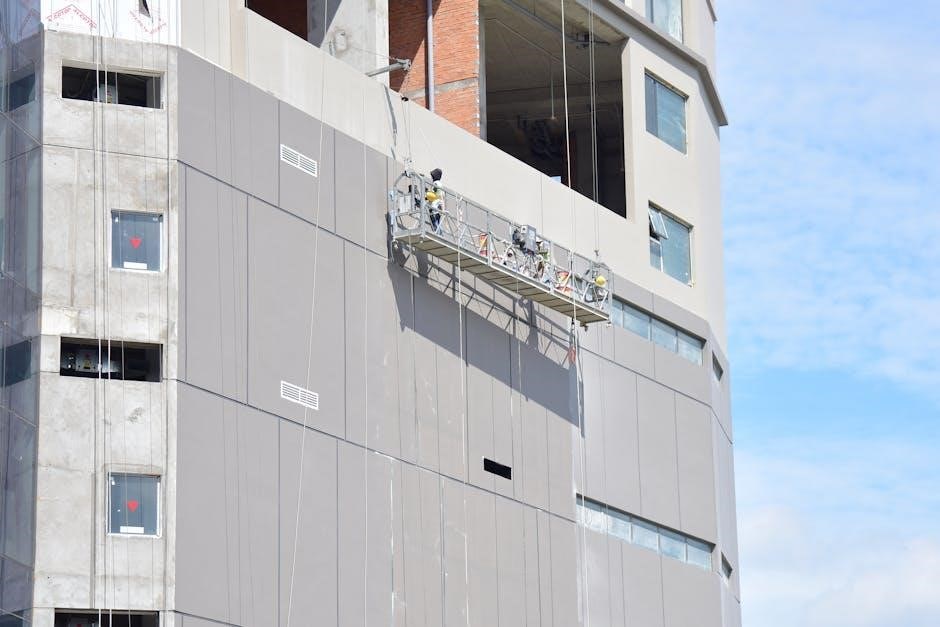Welcome to the Ad Astra Guide, your comprehensive resource for exploring space in Minecraft. This mod offers a universe of possibilities, from building rockets to discovering distant planets like the Moon, Mars, and beyond. Whether you’re crafting space suits, managing oxygen systems, or establishing space stations, this guide will help you navigate the vast cosmos with ease and excitement. Dive in and embark on your interstellar adventure!
1.1 Overview of Ad Astra Mod
The Ad Astra Mod is a space exploration mod for Minecraft, enabling players to travel to celestial bodies like the Moon, Mars, Venus, and Mercury. It introduces a variety of features, including multi-tiered rockets, space suits, and oxygen systems, allowing for immersive interplanetary adventures. The mod focuses on technology and survival, requiring players to craft essential items and manage resources. With its progression system, players unlock higher-tier rockets and advanced equipment, enabling deeper exploration. Compatible with both Fabric and Forge, Ad Astra offers a rich, expansive experience for those eager to venture beyond Earth and establish bases across the solar system.
1.2 Importance of Space Exploration in Minecraft
Space exploration in Minecraft, through mods like Ad Astra, adds a new layer of depth and excitement to the game. It introduces players to the thrill of discovering uncharted celestial bodies, such as the Moon, Mars, and beyond. This feature not only enhances creativity but also challenges players to adapt to new environments and resource-gathering mechanics. Exploring space encourages strategic thinking, as managing oxygen, fuel, and equipment becomes crucial for survival. The ability to establish bases and conduct interplanetary travel expands the game’s possibilities, offering a fresh and immersive experience that keeps players engaged and eager to explore further.
1.3 Purpose of the Guide

This guide is designed to provide players with a detailed roadmap for mastering the Ad Astra mod, ensuring a smooth and enjoyable journey through space exploration in Minecraft. It covers essential topics such as rocket construction, space suit crafting, and survival mechanics, while also offering tips for resource management and advanced progression. The guide aims to equip players with the knowledge needed to explore celestial bodies like the Moon, Mars, and beyond, while establishing sustainable bases and overcoming challenges. Whether you’re a novice or an experienced player, this guide will help you unlock the full potential of the Ad Astra mod and enhance your interstellar adventures.

Getting Started with Ad Astra
Begin your journey by installing the Ad Astra mod via Fabric or Forge. Gather essential resources like steel and oil to craft your first rocket and space suit. Start small, build your foundation, and prepare for liftoff to explore the cosmos!
2.1 Installing the Mod
To begin your interstellar journey, download the Ad Astra mod from CurseForge. Ensure you select the correct version for your Minecraft edition. Install it using either Fabric or Forge mod loaders. Once installed, launch Minecraft with the respective mod loader to access the Ad Astra features. The mod is compatible with both Fabric and Forge, offering flexibility for players. After installation, you’ll have access to essential items like rockets, space suits, and oxygen systems. Make sure your Minecraft version matches the mod’s requirements for seamless functionality. With the mod installed, you’re ready to craft your first rocket and embark on cosmic adventures!
2.2 Basic Setup and Requirements
Before exploring space, ensure you have the necessary materials. Gather Steel for crafting essential items and Ad Astra Oil or Pneumaticraft Oil for fuel. A Nasa Workbench is required to craft rockets and advanced equipment. Install the mod using Fabric or Forge mod loaders, ensuring compatibility with your Minecraft version. For optimal performance, avoid using Optifine or Iris on Fabric. Allocate sufficient resources and space for crafting. Familiarize yourself with the mod’s mechanics to build and fuel rockets effectively. Proper setup ensures a smooth start to your interstellar journey in Ad Astra.
2.3 Understanding the Core Mechanics
The core mechanics of Ad Astra revolve around space exploration and resource management. Players must craft rockets using a Nasa Workbench, which requires materials like steel and oil. The mod introduces a tiered rocket system, with higher tiers enabling travel to distant planets. Fueling is essential, as rockets consume 3 buckets (3000 mB) of oil for launch. Landing requires precise timing, as pressing the spacebar ensures a safe touchdown. The mod also features a progression system, where materials from one planet may be needed to access others. Understanding these mechanics is crucial for a successful interstellar journey in Ad Astra.

Rocket Construction and Fueling
Ad Astra requires crafting rockets in a Nasa Workbench using materials like steel and oil. Fueling with 3 buckets of oil enables launches, while proper landing ensures survival and retrieves the lander.
3.1 Crafting Your First Rocket
Crafting your first rocket in Ad Astra is an exciting milestone. Begin by gathering essential materials, including steel, which is the primary metal required. You’ll need about 2-3 stacks of steel to get started. Next, ensure you have sufficient fuel—around 10-20 buckets of Ad Astra Oil or compatible alternatives like Pneumaticraft Oil. Use the Nasa Workbench to assemble your rocket, following the specific blueprint provided by the mod. Once crafted, fuel your rocket with the prepared oil to prepare for launch. Remember, proper landing is crucial to avoid damage and recover your rocket. This foundational step sets the stage for your interstellar adventures!
3.2 Understanding Rocket Tiers
Ad Astra introduces a tiered rocket system, enabling progressive exploration of the solar system. The mod features four distinct rocket tiers, each unlocking access to more distant and challenging planets. The first tier allows travel to the Moon, while higher tiers enable journeys to Mars, Venus, and beyond. Each tier requires increasingly rare materials and advanced crafting techniques. As you progress, rockets become more fuel-efficient and capable of withstanding harsher conditions. Upgrading your rocket tier is essential for exploring hostile environments and unlocking new resources. This tiered system ensures a balanced and rewarding progression, encouraging players to gather materials and innovate to reach the next frontier.
3.3 Fueling and Launching the Rocket
Fueling and launching your rocket in Ad Astra is a critical step in your space exploration journey. Rockets require a significant amount of fuel, typically 3 buckets (3000 mB) of Ad Astra Oil or compatible alternatives like Pneumaticraft Oil. Once crafted in the Nasa Workbench, your rocket must be properly fueled before launch. Ensure you have enough resources for both the journey and return. Launching requires careful preparation, and landing demands precision—press the spacebar to avoid crashing. Successful launches and landings are essential for progressing through the mod and exploring new celestial bodies. Proper fuel management and planning are key to a successful mission.

Space Suits and Survival Gear
Space suits are essential for survival in Ad Astra, with three tiers offering protection for different planets. Oxygen systems and generators are crucial for extended exploration and base establishment.
4.1 Crafting Space Suits
Crafting space suits is essential for survival in hostile environments. The standard Space Suit is crafted using steel and provides basic protection for planets like the Moon. As you progress, the Netherite Space Suit offers enhanced durability for harsher worlds like Mars and Venus; The advanced Jet Suit includes a built-in jet pack, enabling flight and easier navigation. Each suit requires specific materials and tools, such as a Nasa Workbench. Crafting these suits ensures you can explore safely and efficiently, adapting to the challenges of each planet. Properly equipping yourself is crucial for a successful interstellar journey in Ad Astra.
4.2 Oxygen Systems and Generators
Oxygen systems are vital for survival in space and on other planets. The Oxygen Loader is a key component, converting water into oxygen using a Coal Generator for power. This oxygen can be stored in tanks or directly added to space suits. For extended stays, an Oxygen Distributor creates breathable areas, allowing base establishment without suits. These systems require careful setup and resource management to ensure survival. Properly configuring oxygen generators and distributors is essential for exploring hostile environments and building sustainable bases in Ad Astra.
4.3 Advanced Space Suit Upgrades
Advanced space suit upgrades in Ad Astra enhance survival and mobility in hostile environments. The Jet Suit is a pinnacle upgrade, featuring built-in jet packs for flight across dangerous terrains. It mirrors the Netherite Space Suit in design but adds superior mobility, ideal for navigating lava-rich planets like Venus. Upgrading suits requires progression through the mod, with materials like those found on Mars enabling higher-tier gear. These upgrades ensure better protection and functionality, allowing players to explore farther and survive longer in the harsh conditions of space and alien worlds.

Exploring the Solar System
Embark on an epic journey through the solar system with Ad Astra. Explore the Moon’s low gravity, Mars’ red landscapes, Venus’ hostile environment, and Mercury’s scorched surface. Discover new resources, establish bases, and unravel the mysteries of each celestial body in this vast, interplanetary adventure.
5.1 Traveling to the Moon
To reach the Moon in Ad Astra, you’ll need a Tier 1 rocket, crafted using a Nasa Workbench. Ensure you have 3 buckets of Ad Astra Oil for fuel. Launch your rocket and navigate through the atmosphere. Upon landing, press the spacebar to avoid crashing. The Moon’s low gravity and barren landscape offer a unique environment for exploration. Collect resources and establish a temporary base. Remember to wear a space suit to survive the harsh conditions. The Moon serves as an essential stepping stone for further interplanetary travel, providing valuable materials and experience for your next adventures.
5.2 Exploring Mars and Its Resources
Mars is a vital destination in Ad Astra, offering rich resources and challenges. To survive, equip a Netherite Space Suit, as the planet’s harsh environment demands advanced protection. Mining on Mars yields essential materials for crafting higher-tier equipment and fuel. The planet’s hostile terrain requires careful navigation, with dangers like toxic gases and extreme temperatures. Establishing a base on Mars can serve as a strategic outpost for further exploration. Utilize oxygen generators or distributors to sustain life during extended stays. Resources gathered here are crucial for progressing to more distant planets like Venus and Mercury, making Mars a key stepping stone in your interplanetary journey.
5.3 Venturing to Venus and Mercury
Venus and Mercury offer unique challenges in Ad Astra, requiring advanced preparation. Venus’s thick atmosphere and hostile surface demand a Jet Suit for mobility and survival. Mercury’s extreme temperatures necessitate a well-equipped base to manage heat fluctuations. Both planets provide rare resources essential for crafting higher-tier equipment. Establishing a base on Mercury can serve as a gateway for further solar system exploration. Ensure ample oxygen supply and protective gear when exploring these planets, as their environments are unforgiving. The resources gathered here are crucial for progressing to deeper space, making Venus and Mercury key destinations in your interplanetary journey.
5;4 Establishing Space Stations
Establishing space stations in Ad Astra is a crucial step for advanced exploration. These stations serve as refueling points, storage hubs, and bases for interplanetary operations. To construct one, you’ll need to gather resources like steel and advanced materials. Use a Rocket to transport components to orbit, then assemble the station module by module. Oxygen Distributors and generators are essential for sustaining life. A well-equipped station can also house rovers and additional gear, enabling longer missions; Strategic placement near resource-rich planets like Mars or Venus can enhance your exploration capabilities. Space stations are a testament to your progress and a gateway to deeper space adventures.

Advanced Features and Progression
Ad Astra offers advanced features for seasoned players, including higher-tier rockets, progression systems, and crafting complex equipment. These elements enhance gameplay depth and exploration capabilities significantly.
6.1 Unlocking Higher-Tier Rockets
To unlock higher-tier rockets in Ad Astra, players must progress through the mod’s progression system. Each tier of rocket unlocks new possibilities for space exploration, with Tier 1 being the most basic and Tier 4 allowing travel to distant planets like Venus and Mercury. Crafting higher-tier rockets requires advanced materials, such as steel and rare resources found on other planets. Fuel requirements also increase, necessitating larger storage solutions. As you progress, you’ll gain access to more efficient engines and advanced technologies, enabling longer and more complex missions. Proper landing techniques are crucial to recover your rocket and continue exploring the cosmos.
6.2 Progression System and Upgrades
The Ad Astra progression system is designed to gradually unlock advanced technologies and upgrades, allowing players to explore further into the solar system. As you gather resources and complete challenges, you’ll unlock higher-tier equipment, such as improved space suits and more efficient oxygen generators. Upgrading your gear is essential for surviving harsher environments like Mars and Venus. The progression system also introduces new crafting recipes and tools, enabling the construction of advanced machinery and infrastructure. By progressing through the mod, you’ll gain access to better fuel efficiency, faster travel, and enhanced survival capabilities, making deep space exploration more manageable and rewarding. Each upgrade brings you closer to mastering the cosmos.
6.3 Crafting Advanced Equipment
Crafting advanced equipment in Ad Astra is crucial for progressing through the mod and exploring deeper into the solar system. As you gather rare resources, you can craft higher-tier items like the Jet Suit, which includes built-in jet packs for easier navigation on hostile planets. Advanced oxygen generators and distributors enable sustained survival on distant worlds, while upgraded space suits provide enhanced protection against extreme environments. Crafting these items often requires specialized materials and blueprints unlocked through progression. Each piece of advanced equipment opens new possibilities for exploration and base-building, allowing players to thrive in the harshest conditions. Mastering these crafting recipes is key to conquering the cosmos in Ad Astra.

Tips and Tricks for Success
Mastering Ad Astra requires strategic planning and resource management. Prioritize crafting essential items like oxygen generators and advanced space suits to survive hostile environments. Optimize your base setup for efficiency and sustainability, ensuring a steady supply of fuel and materials. Regularly upgrade your equipment to unlock new possibilities for exploration and progression. Stay alert during space travel and landing to avoid crashes. Experiment with different rocket tiers and suit upgrades to adapt to varying planetary conditions. With careful preparation and smart decisions, you’ll thrive in the vastness of space.
7.1 Managing Resources Effectively
Effective resource management is crucial for success in Ad Astra. Start by gathering essential materials like steel and oil, which are vital for crafting and fueling. Prioritize crafting an Oxygen Generator early to ensure a steady supply for your space suits. Use buckets of water to produce oxygen, and consider setting up an Oxygen Distributor for bases. Fuel management is equally important; store excess oil in tanks to avoid shortages. Plan your missions carefully, carrying enough resources for survival and exploration. Regularly upgrade your equipment to improve efficiency and reduce consumption. By managing resources wisely, you’ll extend your exploration capabilities and thrive in the challenging environments of space.
7.2 Navigating Hostile Environments
Navigating hostile environments in Ad Astra requires careful preparation and the right gear. Planets like Mars and Venus feature extreme conditions, making advanced space suits essential. The Netherite Space Suit is ideal for Mars, while the Jet Suit, with its built-in jet pack, helps avoid hazards like lava pools on Venus; Always carry extra oxygen and consider setting up an Oxygen Distributor for bases to breathe freely. Use water and generators to replenish oxygen supplies, and avoid exploring without proper gear. Hostile environments demand caution, so prioritize survival equipment and plan your missions meticulously to overcome these challenges and thrive in the cosmos.
7.3 Optimizing Your Space Base
Optimizing your space base in Ad Astra is crucial for long-term survival and exploration. Start by ensuring a reliable oxygen supply using an Oxygen Distributor, which converts water into breathable air. Position generators or solar panels near your base to maintain power. Organize your base with modular structures, separating resource storage from living quarters. On planets like Mars, prioritize mining essential materials for upgrades. Use fluid pumps to manage resources efficiently and avoid waste. Consider expanding your base with landing pads for rockets and rovers, enabling easier travel. Regularly replenish supplies and adapt your base design to the planet’s unique challenges, ensuring sustainability and readiness for further exploration.

Mod Compatibility and Troubleshooting
Ad Astra works with Fabric and Forge, but issues may arise with Optifine or Iris, affecting energy transfers. Ensure Minecraft version compatibility and check for updates to resolve bugs and performance issues.
8.1 Compatibility with Fabric and Forge
Ad Astra is designed to work seamlessly with both Fabric and Forge mod loaders, ensuring a smooth experience for Minecraft players. However, compatibility issues may arise with Optifine or Iris, particularly on Fabric, as they can interfere with energy and fluid transfers. To avoid these problems, it’s recommended to disable Optifine or Iris when using Ad Astra. Additionally, ensure your Minecraft version aligns with the mod’s requirements, as compatibility varies across versions. Regularly check for updates to maintain optimal performance and resolve any potential bugs or conflicts with other mods.
8.2 Common Issues and Solutions
Players may encounter issues like crashes or failed rocket launches when using Ad Astra. A common problem is compatibility with Optifine or Iris, which can disrupt energy and fluid transfers. To resolve this, disable these mods or switch to the Forge version. Another issue is the Oxygen Loader not functioning properly, often due to incorrect setup. Ensure it’s powered correctly and connected to a water source. If rockets fail to launch, check fuel levels and ensure the launchpad is clear. For persistent problems, consult the official Ad Astra wiki or forums for troubleshooting guides and updates. Regular mod updates often fix bugs, so keep your version current.
8.3 Optimizing Performance
To ensure smooth gameplay with the Ad Astra mod, optimize your Minecraft setup. Disable mods like Optifine or Iris, as they can cause compatibility issues with Ad Astra’s mechanics; Allocate more RAM to Minecraft to improve performance, especially when exploring resource-intensive planets. Lowering graphics settings and reducing render distance can also enhance gameplay smoothness. Install performance-enhancing mods like Sodium or Lithium alongside Ad Astra for better frame rates. Regularly update your mod to the latest version, as developers often release patches to improve stability and performance. By addressing these factors, you can enjoy a seamless interstellar adventure in Ad Astra.

Community and Resources
Join the vibrant Ad Astra community to connect with fellow space explorers, share tips, and discover new content. Explore forums, YouTube tutorials, and Discord servers for support and inspiration. Utilize community-driven resources like wikis and guides to enhance your gameplay experience and stay updated on mod developments.
9.1 Joining the Ad Astra Community
Become part of the active and welcoming Ad Astra community to connect with fellow space enthusiasts. Join forums, Discord servers, and social media groups to share tips, showcase your creations, and collaborate on projects. Engage with content creators on YouTube and Twitch for tutorials, gameplay streams, and inspiration. Participate in community events and challenges to enhance your experience. The Ad Astra community is a great place to learn, grow, and stay updated on the latest mod developments and updates. By joining, you’ll become part of a passionate group dedicated to exploring the cosmos together in Minecraft.
9.2 Finding Additional Guides and Tutorials
To enhance your Ad Astra experience, explore a variety of guides and tutorials available online. Websites like Minecraft-Guides.com offer detailed walkthroughs, covering topics from basic rocket crafting to advanced space exploration. YouTube channels and forums provide video tutorials, showcasing tips for building efficient rockets, managing resources, and surviving on hostile planets. Additionally, CurseForge and mod-specific wikis offer comprehensive resources, including step-by-step instructions and troubleshooting tips. These guides are perfect for both newcomers and experienced players looking to refine their skills. By leveraging these resources, you can master the complexities of space travel and exploration in Ad Astra.
9.3 Staying Updated with Mod Developments
To stay updated with the latest developments in the Ad Astra mod, regularly check the official CurseForge page for new updates and patch notes. Subscribing to the mod’s newsletter or following its developers on social media can provide early insights into upcoming features. Joining the Ad Astra Discord server or forums allows you to engage with the community, share tips, and learn about beta releases. Additionally, YouTube channels and Minecraft forums often highlight mod updates and tutorials. Keeping your mod version current ensures access to new planets, mechanics, and improvements, enhancing your space exploration experience in Minecraft.
Thank you for exploring the Ad Astra Guide! With this comprehensive resource, you’re ready to embark on thrilling space adventures in Minecraft. Happy crafting and exploring!
10.1 Final Thoughts on Ad Astra
Ad Astra offers an extraordinary journey through space exploration in Minecraft, blending creativity with survival mechanics. From crafting rockets to thriving on distant planets, the mod delivers endless possibilities. Its tiered rocket system and advanced space suits provide a sense of progression, while the need for oxygen and resource management adds depth. The ability to establish bases and explore hostile environments makes each adventure unique. With a gentle learning curve and expansive features, Ad Astra is perfect for both casual players and those seeking a challenging experience. Embark on your cosmic quest, and let the stars guide you to unforgettable discoveries!
10.2 Encouragement to Explore and Create
Embrace the limitless possibilities of Ad Astra and let your creativity shine! Whether you’re designing intricate space stations or venturing to uncharted planets, this mod invites you to push boundaries. Experiment with advanced rocket tiers, craft innovative equipment, and establish thriving bases. The mod’s progression system rewards curiosity and ingenuity, encouraging you to explore further. Don’t hesitate to try new strategies or adapt to challenges—each discovery is a step toward mastery. With its rich features and immersive gameplay, Ad Astra inspires players to dream big and build even bigger. The cosmos awaits; go forth and create your legacy among the stars!






























